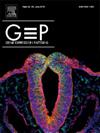Lymphangiogenesis in mouse embryonic and early postnatal ovaries
IF 1.1
4区 生物学
Q4 DEVELOPMENTAL BIOLOGY
引用次数: 0
Abstract
Background
The critical importance and remodeling capacity of the blood vasculature within the ovary have been extensively analyzed, while the lymphatic vasculature has received limited attention, and its characteristics were reported by only a few studies.
Objectives
To investigate the morphological patterns of lymphatic vessel formation in mouse embryonic and early postnatal ovary.
Material and methods
Immunostaining was performed on ovarian tissues from Prox1-EGFP transgenic mice and wild-type mice to investigate the lymphangiogenesis, and the CD31 was employed to label vascular endothelium and LYVE1 and Prox1 as co-markers for lymphatic endothelium.
Result
Prox1+ cells, LYVE1+ cells, and Prox1-EGFP+/LYVE1+ vessels were absent in the medulla near the ovarian hilum until P7, and YAP1 was expressed in the nucleus and cytoplasm of granulosa cells, alongside the observation of scattered primary follicles within the ovary. By P10, these markers were abundantly expressed in the ovarian medulla, while YAP1 was localized primarily in the cytoplasm of granulosa cells, alongside the occurrence of secondary follicles. By P14, Prox1+ cells, LYVE1+ cells, and Prox1-EGFP+/LYVE1+ vessels extended to the cortex, and YAP1 shifted to the nuclei of granulosa cells, alongside the reaching of follicles to the antral stage. From P14 to P28, these markers exhibited a further increasing trend, while YAP1 localized in the nucleus of granulosa cells, alongside the progress of follicles to the preovulatory stage.
Conclusion
Ovarian lymphangiogenesis in the mouse began on postnatal day 7 and subsequently developed from the medulla to the cortex. Additionally, ovarian lymphangiogenesis occurred in synchrony with follicular maturation, during which YAP1 exhibited an ectopic expression pattern.

小鼠胚胎和出生后早期卵巢的淋巴管生成。
背景:卵巢内血管的重要性和重塑能力已经得到了广泛的分析,而淋巴血管受到的关注有限,其特征的报道也很少。目的:探讨小鼠胚胎期和产后早期卵巢淋巴管形成的形态学模式。材料与方法:采用免疫染色法观察Prox1- egfp转基因小鼠和野生型小鼠卵巢组织的淋巴管生成情况,CD31标记血管内皮,LYVE1和Prox1作为淋巴内皮的共标记物。结果:卵巢门附近髓质至P7无Prox1+细胞、LYVE1+细胞和Prox1- egfp +/LYVE1+血管,颗粒细胞细胞核和细胞质中有YAP1表达,卵巢内可见散在的初代卵泡。P10时,这些标记物在卵巢髓质中大量表达,主要分布在颗粒细胞的细胞质中,伴随着继发卵泡的出现。到P14期,Prox1+细胞、LYVE1+细胞和Prox1- egfp +/LYVE1+血管延伸到皮层,YAP1转移到颗粒细胞的细胞核,同时到达卵泡至正中期。从P14到P28,随着卵泡进入排卵期,这些标记物呈进一步增加的趋势。结论:小鼠卵巢淋巴管生成始于出生后第7天,随后由髓质向皮层发育。此外,卵巢淋巴管生成与卵泡成熟同步发生,在此过程中YAP1表现出异位表达模式。
本文章由计算机程序翻译,如有差异,请以英文原文为准。
求助全文
约1分钟内获得全文
求助全文
来源期刊

Gene Expression Patterns
生物-发育生物学
CiteScore
2.30
自引率
0.00%
发文量
42
审稿时长
35 days
期刊介绍:
Gene Expression Patterns is devoted to the rapid publication of high quality studies of gene expression in development. Studies using cell culture are also suitable if clearly relevant to development, e.g., analysis of key regulatory genes or of gene sets in the maintenance or differentiation of stem cells. Key areas of interest include:
-In-situ studies such as expression patterns of important or interesting genes at all levels, including transcription and protein expression
-Temporal studies of large gene sets during development
-Transgenic studies to study cell lineage in tissue formation
 求助内容:
求助内容: 应助结果提醒方式:
应助结果提醒方式:


